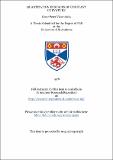Files in this item
Quantization in spaces of constant curvature
Item metadata
| dc.contributor.advisor | Wan, Kong K. | |
| dc.contributor.author | Viazminsky, Cesar Peter | |
| dc.coverage.spatial | 168 p. | en_US |
| dc.date.accessioned | 2018-06-25T14:15:42Z | |
| dc.date.available | 2018-06-25T14:15:42Z | |
| dc.date.issued | 1978 | |
| dc.identifier.uri | https://hdl.handle.net/10023/14549 | |
| dc.description.abstract | Quantization in generalized coordinate systems and in non-Euclidean spaces has attracted much recent attention. The aim of this thesis is to discuss the problem for spaces of constant curvature. Chapter I is a brief review of tensor analysis on manifolds and the Hamiltonian formulation of classical mechanics. Chapter II deals with the canonical quantization scheme. It is proved that this scheme is unsatisfactory since it often fails to produce an essentially self-adjoin operator corresponding to a generalized momentum. It is shown that the only case for which we can obtain a unique well-defined pair of canonical quantum observables is that when the range of the generalized coordinate is the entire real line. Chapter III is devoted for discussing the quantization in spaces of constant curvature. An approach by Mackey circumvents the difficulties facing the canonical quantization scheme and is adopted instead. It is shown that a more physical meaning is gained if we impose on Mackey's momenta the condition that they are metric- preserving. Such a condition makes the momenta constants of the free motion. §4 in essence demonstrates that the dynamics in a space of constant curvature are rooted in its geometry. Utilizing the metric-preserving momenta, the quantum Hamiltonian is built up from symmetry considerations, and is uniquely determined as the Laplacian up to a multiplicative constant and an additive constant. In §5-§8 the quantization in spaces of constant curvature is studied in detail. The quantum and classical momenta are found explicitly. Eigenvalues and Eigenfunctions of the momentum observables are evaluated. Also it is shown that spaces of different curvature are physically distinguishable. An interesting relation between the momenta, the curvature of the space and the Hamiltonian holds classically and quantum-mechanically. The well-known relation giving the Hamiltonian as proportional to the sum of squares of the momenta (in Euclidean spaces with Cartesian coordinates) is just a special case of a more general relation in which the momenta, the angular momenta and the curvature of the space take part in forming the Hamiltonian classically or quantum-mechanically. §9 of chapter III discusses the Lie algebraic treatment of quantization. It is shown that such a treatment cannot be taken as a general quantization scheme. The sets of all classical and quantal momenta (metric-preserving and non- metric-preserving) do not form Lie algebras. However when we confine ourselves to those momenta which are generated by motions of the space, then these sets form isomorphic Lie algebras. The striking parallelism between quantum and classical mechanics observed throughout §4-§8 is pushed further in §9. It is shown that the quantum and classical Hamiltonians are, respectively, related to the Casimir operators of the Lie algebras of quantum and classical momenta in the same way. Chapter IV envisages the problem of quantization from an intrinsic point of view. A space of constant curvature is looked on as a hypersurface in a flat space. In §4 we verify that Dirac's scheme for quantizing a constrained classical system works when the constraints are geometrical. | en_US |
| dc.language.iso | en | en_US |
| dc.publisher | University of St Andrews | |
| dc.subject.lcc | QC174.4V5 | |
| dc.subject.lcsh | Quantum statistics | En |
| dc.title | Quantization in spaces of constant curvature | en_US |
| dc.type | Thesis | en_US |
| dc.contributor.sponsor | Syria. Ministry of Higher Education | en_US |
| dc.type.qualificationlevel | Doctoral | en_US |
| dc.type.qualificationname | PhD Doctor of Philosophy | en_US |
| dc.publisher.institution | The University of St Andrews | en_US |
This item appears in the following Collection(s)
Items in the St Andrews Research Repository are protected by copyright, with all rights reserved, unless otherwise indicated.

